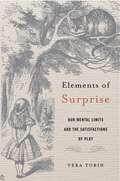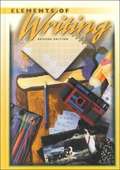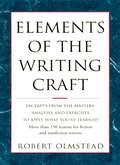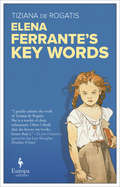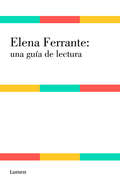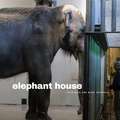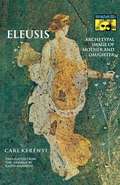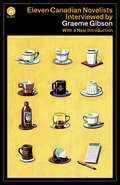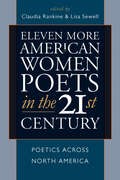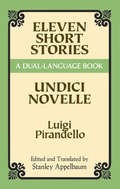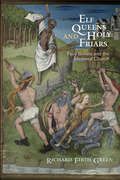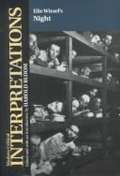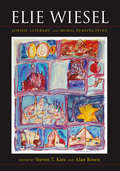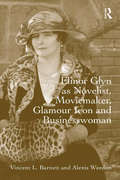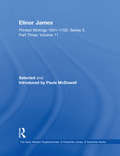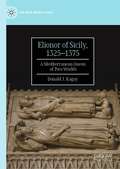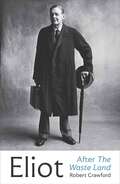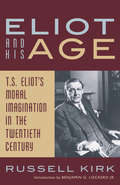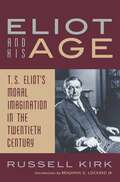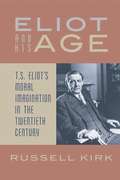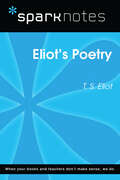- Table View
- List View
Elements of Surprise: Our Mental Limits and the Satisfactions of Plot
by Vera TobinWhy do some surprises delight—the endings of Agatha Christie novels, films like The Sixth Sense, the flash awareness that Pip’s benefactor is not (and never was!) Miss Havisham? Writing at the intersection of cognitive science and narrative pleasure, Vera Tobin explains how our brains conspire with stories to produce those revelatory plots that define a “well-made surprise.” By tracing the prevalence of surprise endings in both literary fiction and popular literature and showing how they exploit our mental limits, Tobin upends two common beliefs. The first is cognitive science’s tendency to consider biases a form of moral weakness and failure. The second is certain critics’ presumption that surprise endings are mere shallow gimmicks. The latter is simply not true, and the former tells at best half the story. Tobin shows that building a good plot twist is a complex art that reflects a sophisticated understanding of the human mind. Reading classic, popular, and obscure literature alongside the latest research in cognitive science, Tobin argues that a good surprise works by taking advantage of our mental limits. Elements of Surprise describes how cognitive biases, mental shortcuts, and quirks of memory conspire with stories to produce wondrous illusions, and also provides a sophisticated how-to guide for writers. In Tobin’s hands, the interactions of plot and cognition reveal the interdependencies of surprise, sympathy, and sense-making. The result is a new appreciation of the pleasures of being had.
Elements of Writing Third Course
by James L. Kinneavy John E. WarrinerA language arts textbook covering the following areas in three parts: PART 1 Writing PART 2 Handbook PART 3 Resources
Elements of Writing: Fourth Course (Revised Edition 10th Grade)
by James L. Kinneavy John E. WarrinerWriting textbook
Elements of Writing: Introductory Course (Revised Edition)
by James L. Kinneavy John E. WarrinerIntroductory textbook on writing and grammar.
Elements of the Writing Craft: More Than 150 Lessons for Fiction and Nonfiction Writers
by Robert OlmsteadGreat narratives are built piece by piece, through myriad small tasks and careful moves. In this landmark book, Robert Olmstead shows how distinguished writers past and present have built their fiction and nonfiction. Through this writer's-eye analysis of more than 150 of literature's most finely crafted passages, you'll learn to read like a writer. Then, more than 500 innovative exercises challenge you to experiment with - and expand upon - the techniques of the masters, so you can use them for great narratives of your own.
Elena Ferrante's Key Words
by Tiziana de Rogatis“Tackles novelist Elena Ferrante’s Neapolitan quartet in terms of their ‘creative forms of [female] resistance’ . . . A richly layered study.” —Kirkus Reviews“I greatly admire the work of Tiziana de Rogatis. She is a reader of deep refinement. Often I think that she knows my books better than I. So, I read her with admiration and remain silent.” —Elena Ferrante, in the magazine, San Lian Sheng Huo Zhou KanFerrante’s four-volume novel cycle known in English as the Neapolitan quartet has become a global success, with over ten million readers in close to fifty countries. Her readers recount feeling “addicted” to the novels; they describe a pleasure in reading that is as rare as it is irresistible, a compulsion that leads them either to devour the books or to ration them so as to prolong the pleasure.De Rogatis here addresses that same transnational, diverse, transversal audience. Elena Ferrante’s Key Words is conceived as a lighted path made of luminous key words that synthesize the multiform aspects of Ferrante’s writing and guide us through the labyrinth of her global success.“An exceptional companion to the source material, particularly for the lit-crit crowd looking to affirm Ferrante’s reinvention of the future of the novel.” —Library Journal
Elena Ferrante: una guía de lectura
by Ilaria MartinelliTodo lo que necesitas saber para adentrarte en la fiebre Ferrante. Nadie sabe quién es Elena Ferrante, y sus editores de origen procuran mantener un silencio absoluto sobre su identidad. Hay quien ha llegado a sospechar que es un hombre; otros dicen que nació en Nápoles pero que ahora vive en Turín. La mayoría de críticos la saludan como la nueva Elsa Morante, una voz extraordinaria que ha dado un vuelco a la narrativa de los últimos años. Su éxito entre la crítica y el público se refleja en artículos publicados por periódicos y revistas tan notables como The New York Times y The Paris Review. En 2011, Lumen publicó un volumen titulado Crónicas del desamor, donde se reunían El amor molesto, Los días del abandono y La hija oscura, sus tres primeras novelas. Luego vino la saga compuesta por La amiga estupenda, Un mal nombre, Las deudas del cuerpo y, finalmente, La niña perdida, un cuarto volumen que cierra una obra destinada a convertirse en un clásico de la literatura europea del siglo XXI. «No me arrepiento de mi anonimato. Descubrir la personalidad de quien escribe a través de las historias que propone, de sus personajes, de los objetos y paisajes que describe, del tono de su escritura, no es ni más ni menos que un buen modo de leer.»Elena Ferrante en una entrevista por correo con Paolo di Stefano para Il Corriere della Sera
Elephant House (Animalibus)
by Nigel RothfelsIn Elephant House, photographer Dick Blau and historian Nigel Rothfels offer a thought-provoking study of the Oregon Zoo’s Asian Elephant Building and the daily routines of its residents—human and pachyderm alike. Without an agenda beyond a desire to build a deeper understanding of this enigmatic environment, Elephant House is the result of the authors’ unique creative collaboration and explores the relationships between captive elephants and their human caregivers.Blau’s evocative photographs are complex and challenging, while Rothfels’s text offers a scholarly and personal response to the questions that surround elephants and captivity. Elephant House does not take sides in the debate over zoos but focuses instead on the bonds of attentiveness between the animals and their keepers. Accompanied by a foreword from retired elephant keeper Mike Keele, Elephant House is a frank, fascinating look at the evolving world of elephant husbandry.
Elephant House (Animalibus: Of Animals and Cultures #7)
by Dick Blau Nigel RothfelsIn Elephant House, photographer Dick Blau and historian Nigel Rothfels offer a thought-provoking study of the Oregon Zoo’s Asian Elephant Building and the daily routines of its residents—human and pachyderm alike. Without an agenda beyond a desire to build a deeper understanding of this enigmatic environment, Elephant House is the result of the authors’ unique creative collaboration and explores the relationships between captive elephants and their human caregivers.Blau’s evocative photographs are complex and challenging, while Rothfels’s text offers a scholarly and personal response to the questions that surround elephants and captivity. Elephant House does not take sides in the debate over zoos but focuses instead on the bonds of attentiveness between the animals and their keepers. Accompanied by a foreword from retired elephant keeper Mike Keele, Elephant House is a frank, fascinating look at the evolving world of elephant husbandry.
Eleusis: Archetypal Image of Mother and Daughter (Bollingen Series (General) #634)
by Carl KerényiThe Sanctuary of Eleusis, near Athens, was the center of a religious cult that endured for nearly two thousand years and whose initiates came from all parts of the civilized world. Looking at the tendency to "see visions," C. Kerenyi examines the Mysteries of Eleusis from the standpoint not only of Greek myth but also of human nature. Kerenyi holds that the yearly autumnal "mysteries" were based on the ancient myth of Demeter's search for her ravished daughter Persephone--a search that he equates not only with woman's quest for completion but also with every person's pursuit of identity. As he explores what the content of the mysteries may have been for those who experienced them, he draws on the study of archaeology, objects of art, and religious history, and suggests rich parallels from other mythologies.
Elevating Humanity via Africana Womanism (Routledge Focus on Literature)
by Clenora Hudson (Weems)Elevating Humanity via Africana Womanism is a short, but powerful book, advocating synergy via unity/collectivity as a panacea for all societal ills. It discusses the Africana Womanism theory - an authentic family centered concept for all women of African descent - as a grid upon which to erect the private and public personae of all positive Africana people. Within the context of our cultural and historical matrix, it opens with defining the paradigm, while promoting the importance of prioritizing race, class and gender, the triple plight of Black women. A workable strategy for ensuring equality for all, it closes on a note of love and spirituality, while embracing the special connection between Africana men and women, the 2-sided human coin.This introduction logically and convincingly speaks truth to power about who we, Black women are, beginning, in Part One, with naming and defining ourselves, with the foreknowledge of the seminal role of our male counterparts. It identifies the 18 descriptors of the true Africana woman and her male counterpart. Part Two offers fruitful commentary, via sharing some of the many contributions we have given to society, which could enhance self-esteem among our people, many of whom have come to not love themselves and even their own, due to inadequate historical documentation.
Eleven Canadian Novelists Interviewed by Graeme Gibson: From Eleven Canadian Novelists Interviewed By Graeme Gibson (A List)
by Graeme GibsonOriginally published in 1970, Eleven Canadian Novelists Interviewed by Graeme Gibson is a collection of candid and wide-ranging interviews with Canadian writers, including Alice Munro, Mordecai Richler, Margaret Laurence, and more.With the intuition of an insider, Gibson asks the important questions: In what way is writing important to you? Do writers know something special? Does he or she have any responsibility to society? The result is a fascinating and immensely readable series of conversations with famed writers at the beginning of their careers.The A List edition will feature a new introduction by Graeme Gibson and interviews with the following authors:Margaret AtwoodAustin ClarkeMatt CohenMarian EngelTimothy FindleyDave GodfreyMargaret LaurenceJack LudwigAlice MunroMordecai RichlerScott Symons
Eleven More American Women Poets in the 21st Century: Poetics across North America (American Poets in the 21st Century)
by Lisa Sewell Claudia RankineEleven More American Women Poets in the 21st Century is an exciting sequel to its predecessors in the American Poets in the 21st Century series. Like the earlier anthologies, this volume includes generous selections of poetry by some of the best poets of our time as well as illuminating poetics statements and incisive essays on their work. This unique organization makes these books invaluable teaching tools. Broadening the lens through which we look at contemporary poetry, this new volume extends its geographical net by including Caribbean and Canadian poets. Representing three generations of women writers, among the insightful pieces included in this volume are essays by Karla Kelsey on Mary Jo Bang's modes of artifice, Christine Hume on Carla Harryman's kinds of listening, Dawn Lundy Martin on M. NourbeSe Phillip (for whom "english / is a foreign anguish"), and Sina Queyras on Lisa Robertson's confoundingly beautiful surfaces. A companion web site will present audio of each poet's work.
Eleven Short Stories: A Dual-Language Book (Dover Dual Language Italian)
by Luigi PirandelloWinner of the 1934 Nobel Prize for literature, Luigi Pirandello (1867 - 1936) is best known for such landmark plays as Six Characters in Search of an Author. One of the great literary figures of the twentieth century, he also distinguished himself in a vast outpouring of short stories, poetry, novels, and essays. The stories often provided the seeds for later novels and plays.The 11 tales included in this collection are among his best. Presented in the original Italian with excellent new English translations on facing pages, they offer students of Italian language and literature a unique learning aid and a treasury of superb fiction by a modern master.The stories range in time from the earliest known tale, "Little Hut," a study of rural passions written in 1884, to "Mrs. Frola and Mr. Ponza, Her Son-in-Law," a quintessential Pirandello story about the relativity of truth and the impossibility of penetrating other people's minds. Published in 1917, it formed the basis of Pirandello's first major play, Right You Are If You Think You Are. In addition to these narratives, the volume also includes "Citrons from Sicily," "With Other Eyes," "A Voice," "The Fly," "The Oil Jar," "It's Not to be Taken Seriously," "Think it Over, Giacomino!," "A Character's Tragedy," and "A Prancing Horse."Accompanying the stories are a biographical and critical introduction to Pirandello and his work, brief introductions to each of the stories and explanatory footnotes.
Elf Queens and Holy Friars: Fairy Beliefs and the Medieval Church (The Middle Ages Series)
by Richard Firth GreenIn Elf Queens and Holy Friars Richard Firth Green investigates an important aspect of medieval culture that has been largely ignored by modern literary scholarship: the omnipresent belief in fairyland.Taking as his starting point the assumption that the major cultural gulf in the Middle Ages was less between the wealthy and the poor than between the learned and the lay, Green explores the church's systematic demonization of fairies and infernalization of fairyland. He argues that when medieval preachers inveighed against the demons that they portrayed as threatening their flocks, they were in reality often waging war against fairy beliefs. The recognition that medieval demonology, and indeed pastoral theology, were packed with coded references to popular lore opens up a whole new avenue for the investigation of medieval vernacular culture.Elf Queens and Holy Friars offers a detailed account of the church's attempts to suppress or redirect belief in such things as fairy lovers, changelings, and alternative versions of the afterlife. That the church took these fairy beliefs so seriously suggests that they were ideologically loaded, and this fact makes a huge difference in the way we read medieval romance, the literary genre that treats them most explicitly. The war on fairy beliefs increased in intensity toward the end of the Middle Ages, becoming finally a significant factor in the witch-hunting of the Renaissance.
Elie Wiesel's Night (Modern Critical Interpretations)
by Harold Bloom Elie WieselCritical essays discuss Elie Wiesel's autobiographical novel about his time spent in Auschwitz as a teenager.
Elie Wiesel: Jewish, Literary, and Moral Perspectives (Jewish Literature And Culture Ser.)
by Steven T. Katz and Alan Rosen&“Illuminating . . . 24 academic essays covering Wiesel&’s interpretations of the Bible, retellings of Talmudic stories . . . his post-Holocaust theology, and more.&” —Publishers Weekly Nobel Peace Prize recipient Elie Wiesel, best known for his writings on the Holocaust, is also the accomplished author of novels, essays, tales, and plays as well as portraits of seminal figures in Jewish life and experience. In this volume, leading scholars in the fields of Biblical, Rabbinic, Hasidic, Holocaust, and literary studies offer fascinating and innovative analyses of Wiesel&’s texts as well as enlightening commentaries on his considerable influence as a teacher and as a moral voice for human rights. By exploring the varied aspects of Wiesel&’s multifaceted career—his texts on the Bible, the Talmud, and Hasidism as well as his literary works, his teaching, and his testimony—this thought-provoking volume adds depth to our understanding of the impact of this important man of letters and towering international figure. &“This book reveals Elie Wiesel&’s towering intellectual capacity, his deeply held spiritual belief system, and the depth of his emotional makeup.&” —New York Journal of Books &“Close, scholarly readings of a master storyteller&’s fiction, memoirs and essays suggest his uncommon breadth and depth . . . Criticism that enhances the appreciation of readers well-versed in the author&’s work.&” —Kirkus Reviews &“Navigating deftly among Wiesel&’s varied scholarly and literary works, the authors view his writings from religious, social, political, and literary perspectives in highly accessible prose that will well serve a broad and diverse readership.&” —S. Lillian Kremer author of Women&’s Holocaust Writing: Memory and Imagination
Elinor Glyn as Novelist, Moviemaker, Glamour Icon and Businesswoman
by Vincent L. Barnett Alexis WeedonThe first full-length study of the authorial and cross-media practices of the English novelist Elinor Glyn (1864-1943), Elinor Glyn as Novelist, Moviemaker, Glamour Icon and Businesswoman examines Glyn’s work as a novelist in the United Kingdom followed by her success in Hollywood where she adapted her popular romantic novels into films. Making extensive use of newly available archival materials, Vincent L. Barnett and Alexis Weedon explore Glyn’s experiences from multiple perspectives, including the artistic, legal and financial aspects of the adaptation process. At the same time, they document Glyn’s personal and professional relationships with a number of prominent individuals in the Hollywood studio system, including Louis B. Mayer and Irving Thalberg. The authors contextualize Glyn’s involvement in scenario-writing in relationship to other novelists in Hollywood, such as Edgar Wallace and Arnold Bennett, and also show how Glyn worked across Europe and America to transform her stories into other forms of media such as plays and movies. Providing a new perspective from which to understand the historical development of both British and American media industries in the first half of the twentieth century, this book will appeal to historians working in the fields of cultural and film studies, publishing and business history.
Elinor James: Printed Writings 1641–1700: Series II, Part Three, Volume 11 (The Early Modern Englishwoman: A Facsimile Library of Essential Works & Printed Writings, 1641-1700: Series II, Part Three)
by Paula McDowellThis volume makes available for the first time the complete surviving works of the London printer-author Elinor James (c.1645-1719). Uniquely in the history of early modern women, James wrote, printed and distributed more than ninety pamphlets and broadsides addressing political, religious and commercial concerns. Written over a period of 35 years, her works provide us with a running commentary on the major national events of a tumultuous period such as the Revolution of 1688, the Union of England and Scotland in 1707, and the Jacobite uprisings in 1715-16. During her lifetime, England saw the succession of six different monarchs. James petitioned all of them and claimed to have obtained audiences with three. In 1689 she was gaoled in Newgate prison, accused of disseminating seditious material condemning William III for accepting the English crown. James's texts address a staggeringly broad range of concerns. She petitioned Parliament concerning legislation affecting the printing trades and petitioned fellow printers concerning labour relations in London printing houses. She petitioned City authorities on issues such as the enforcement of bylaws or who to vote for in City and parliamentary elections. It is hoped that by making available all of James's known works, this volume will inspire the collective efforts of scholars from many different disciplines to decipher her references to contemporary events, issues and persons, as well as prompting further discoveries of as yet unidentified works.
Elionor of Sicily, 1325–1375: A Mediterranean Queen of Two Worlds (The New Middle Ages)
by Donald J. KagayElionor of Sicily, 1325–1375: A Mediterranean Queen’s Life of Family, Administration, Diplomacy, and War follows Elionor of Sicily, the third wife of the important Aragonese king, Pere III. Despite the limited amount of personal information about Elionor, the large number of Sicilian, Catalan, and Aragonese chronicles as well as the massive amount of notarial evidence drawn from eastern Spanish archives has allowed Donald Kagay to trace Elionor’s extremely active life roles as a wife and mother, a queen, a frustrated sovereign, a successful administrator, a supporter of royal war, a diplomat, a feudal lord, a fervent backer of several religious orders, and an energetic builder of royal sites. Drawing from the correspondence between the queen and her husband, official papers and communiques, and a vast array of notarial documents, the book casts light on the many phases of the queen’s life.
Eliot After "the Waste Land"
by Robert CrawfordThe second volume of Robert Crawford's magisterial biography of the revolutionary modernist, visionary poet and troubled man, drawing on extensive new sources. In this compelling and meticulous portrait of the twentieth century's most important poet, Robert Crawford completes the story he began in Young Eliot. Drawing on extensive new sources and letters, this is the first full-scale biography to make use of Eliot's most significant surviving correspondence, including the archive of letters (unsealed for the first time in 2020) detailing his decades-long love affair with Emily Hale. This long-awaited second volume, Eliot After 'The Waste Land', tells the story of the mature Eliot, his years as a world-renowned writer and intellectual, and his troubled interior life. From his time as an exhausted bank employee after the publication of The Waste Land, through the emotional turmoil of the 1920s and 1930s, and his years as a firewatcher in bombed wartime London, Crawford reveals the public and personal experiences that helped generate some of Eliot's masterpieces. He explores the poet's religious conversion, his editorship at Faber and Faber, his separation from Vivien Haigh-Wood and happy second marriage to Valerie Fletcher, and his great work Four Quartets. Robert Crawford presents this complex and remarkable man not as a literary monument but as a human being: as a husband, lover and widower, as a banker, editor, playwright and publisher, but most of all as an epoch-shaping poet struggling to make art among personal disasters.
Eliot and His Age: T. S. Eliot's Moral Imagination in the Twentieth Century
by Russell KirkEliot and His Age remains the best introduction to T. S. Eliot’s life, ideas, and literary works. It is the essential starting place for anyone who would understand what Eliot was about. Russell Kirk’s view of his older friend is sympathetic but not adulatory. His insights into Eliot’s writings are informed by wide reading in the same authors who most influenced the poet, as well as by similar experiences and convictions.Kirk elaborates here a significant theory of literary meaning in general, showing how great literary works awaken our intuitive reason, giving us profound visions of truth that transcend logical processes. And he traces Eliot’s political and cultural ideas to their true sources, showing the balance and subtlety of Eliot’s views. Eliot and His Age is a literary biography that will endure when much of the more recent writing on Eliot is gathering dust.
Eliot and His Age: T. S. Eliot's Moral Imagination in the Twentieth Century
by Russell KirkThough much has been written about T. S. Eliot since it was first published, Eliot and His Age remains the best introduction to the poet's life, ideas, and literary works. It is the essential starting place for anyone who would understand what Eliot was about. Russell Kirk's view of his older friend is sympathetic but not adulatory. His insights into Eliot's writings are informed by wide reading in the same authors who most influenced the poet, as well as by similar experiences and convictions. Kirk elaborates here a significant theory of literary meaning in general, showing how great literary works awaken our intuitive reason, giving us profound visions of truth that transcend logical processes. And he traces Eliot's political and cultural ideas to their true sources, showing the balance and subtlety of Eliot's views. Eliot and His Age is a literary biography that will endure when much of the more recent writing on Eliot is gathering dust.
Eliot and His Age: T. S. Eliot's Moral Imagination in the Twentieth Century (2nd edition)
by Russell KirkThough much has been written about T. S. Eliot since it was first published, Eliot and His Age remains the best introduction to the poet's life, ideas, and literary works. It is the essential starting place for anyone who would understand what Eliot was about. Russell Kirk's view of his older friend is sympathetic but not adulatory. His insights into Eliot's writings are informed by wide reading in the same authors who most influenced the poet, as well as by similar experiences and convictions.
Eliot's Poetry (SparkNotes Literature Guide Series)
by SparkNotesEliot's Poetry (SparkNotes Literature Guide) by T.S. Eliot Making the reading experience fun! Created by Harvard students for students everywhere, SparkNotes is a new breed of study guide: smarter, better, faster.Geared to what today's students need to know, SparkNotes provides:chapter-by-chapter analysis explanations of key themes, motifs, and symbols a review quiz and essay topics Lively and accessible, these guides are perfect for late-night studying and writing papers.
